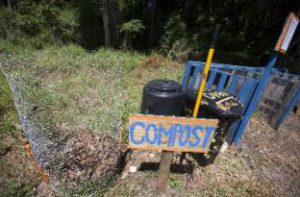Much of the trash that we throw away can be used to make our gardens more productive. A great New Year’s resolution is to begin to covert yard and kitchen debris into soil-enriching compost.

Many materials can be used to produce compost. Grass clippings, leaves, egg shells, coffee grounds, tea bags, vegetable and fruit clippings, shredded paper and chopped brush are a few examples of organic matter suitable for composting. Cheese, meat scraps, fats or bones should be avoided as they may attract pests like rodents. Also, these materials are slower to decompose and may create an odor problem.
The size of a compost bin may vary but the enclosure needs to be at least 3 feet by 3 feet by 3 feet. It can be made from almost anything: wire, wooden pallets or cement blocks. One side should be either open or removable for ease of adding and removing materials from the bin.
A simple compost container is a wire hoop made from welded fence wire. The piece of fence wire should be long enough to make a 3-foot diameter hoop. This hoop bin is sturdy enough to stand upright on its own with no additional support.
The below link to the UF/IFAS Extension publication Compost Tips for the Home Gardener states, “To create the compost pile, layer roughly equal amounts of “green” materials and “brown” materials in alternating 3- to 4-inch tiers up to a height of about 3 feet. Smaller particles will decompose faster than larger materials. It is essential that each layer be watered as you build the pile; otherwise it is almost impossible to moisten the center of the pile once it is completed. The materials should be moist, not soggy. There is no advantage to purchasing a compost “starter,” since organic yard wastes naturally contain the microorganisms needed to start the decomposition process.”
Examples for “green” materials are fresh lawn grass clippings and vegetable scraps. Examples of ‘brown” materials are dry fall tree leaves and small tree and shrub twigs.
Frequent turning of the compost materials with a shovel or pitchfork will benefit the bacteria and fungi, resulting in faster decomposition of the organic materials. When using the wire hoop method, simply pick up the wire hoop and set it to the side of the pile of compost. Next, use a pitchfork or shovel to place the compost materials back into the wire hoop in its new location.
Adopt composting for a more productive garden in 2022.
More information on composting is available at http://edis.ifas.ufl.edu/ep323 or through the UF/IFAS Extension Office in your County.
 0
0
